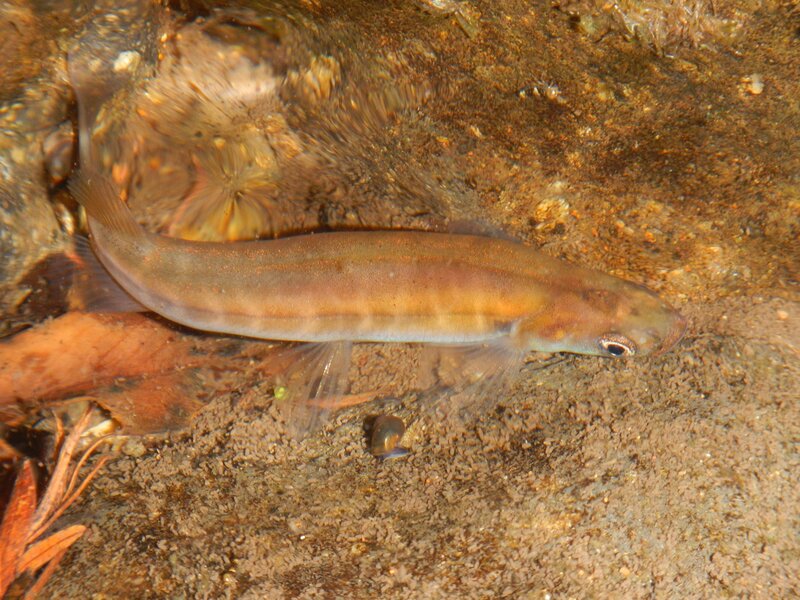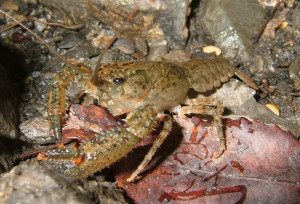What lives in the Waikato River?
Native fish

Banded kōkopu
The Waikato River and its associated wetlands and lakes are home to many different types of fish, including 19 native species. The river supports a large recreational whitebait fishery and a large commercial eel fishery. The table below lists native freshwater fish and crustaceans found in the lower Waikato River catchment.
Table 1: Native freshwater fish and crustaceans of the lower Waikato River catchment
| Common name (Māori name) | Scientific name |
| Yellow-eyed mullet (aua/kātaha) | Aldrichetta forsteri |
| Shortfin eel (hao) | Anguilla australis |
| Longfin eel (Kūwharuwharu) | Anguilla dieffenbachii |
| Australian longfin eel | Anguilla reinhardtii |
| Lamprey (pirahau) | Geotria australis |
| Torrentfish (papamoko) | Cheimarrichthys fosteri |
| Giant kōkopu (kōkopu) | Galaxias argenteus |
| Kōaro | Galaxias brevipinnis |
| Banded kōkopu (para) | Galaxias fasciatus |
| Inanga | Galaxias maculatus |
| Short-jawed kōkopu | Galaxias postvectis |
| Black mudfish | Neochanna diversus |
| Giant bully | Gobiomorphus gobiodes |
| Common bully (pako) | Gobiomorphus cotidianus |
| Redfin bully | Gobiomorphus huttoni |
| Cran’s bully | Gobiomorphus basalis |
| Grey mullet | Mugil cephalus |
| Common smelt (ngaoire) | Retropinna retropinna |
| Black flounder (pātiki) | Rhombosolea retiaria |
| Freshwater crayfish (kōura) | Paranephrops planifrons |
| Shrimp (kōuraura) | Paratya curvirostris |
Many of New Zealand’s native freshwater fish are migratory and need access to the sea or an estuary during their lifecycle. Barriers such as dams and poorly installed culverts can stop these fish from being able to successfully migrate to their breeding grounds or adult habitats. Find out more about fish access.
Natural obstacles such as waterfalls and rapids can also limit fish access. Even before the Waikato River dams were built, few migratory fish would have managed to reach the current location of the Arapuni hydro dam because of the very large rapids in the area.
Introduced fish
The Waikato River and its associated wetlands and lakes now contain at least 10 introduced fish species, and support a winter trout fishery.
Some introduced fish, such as koi carp and Gambusia, have become major pests. The table below lists introduced freshwater fish found in the lower Waikato River catchment.
Table 2: Introduced freshwater fish found in the lower Waikato River catchment
| Common name | Scientific name |
| Catfish | Ameiurus nebulosus |
| Goldfish | Carassius auratus |
| Grass carp | Ctenopharyngodon idella |
| Koi carp | Cyprinus carpio |
| Gambusia or mosquito fish | Gambusia affinis |
| Rainbow trout | Onchorhycchus mykiss |
| Perch | Perca fluviatilis |
| Brown trout | Salmo trutta |
| Rudd | Scardinius erythropthalmus |
| Tench | Tinca tinca |
River invertebrates

Small northern kōura (freshwater crayfish)
Invertebrates are animals without backbones. They include insects, snails, worms and crustaceans, such as kōura (freshwater crayfish). Different types of invertebrates live in different parts of the River, depending on the water quality and the river bed substrate, for example, whether the river bed is sandy or rocky.
Soft shallow shorelines are usually covered by under water plants. They provide a home for damselfly larvae, small fish, snails, fine algae and beetles. Rocky areas in shallow parts of the River are home to small filamentous algae and sponges.
Hydro lakes
The plants and animals in the hydro lakes along the Waikato River are quite different to those that live in flowing parts of the river. The hydro lakes contain:
- A wide variety of fish, including brown and rainbow trout, catfish, smelt, rudd, common bullies, elvers (baby eels), goldfish and carp.
- Other animals including freshwater sponges, insects and snail larvae, pea mussels and freshwater mussels.
Plant-life in and around the lakes consists of:
- Hornwort and the oxygen weed Egeria densa are the most abundant aquatic plants.
- Sweetgrass, bull rush, raupo and assorted reeds along the lake shores.
- Deeper down (10 to 30 metres), the algal cover on plants and rocks fades out as light levels decrease.
The eight Waikato River hydro lakes are:
- Lake Aratiatia
- Lake Ohakuri
- Lake Ātiamuri
- Lake Whakamaru
- Lake Maraetai
- Lake Waipapa
- Lake Arapuni
- Lake Karāpiro.
Threats to life in the river
- High levels of sediment, which reduce light levels needed for plant growth (photosynthesis).
- Low levels of oxygen in the water for fish to breathe (a result of pollutants that consume oxygen as they break down).
- High levels of nutrients such as nitrogen and phosphorus, which promote the growth of nuisance plants, shading out or out-competing native species.
- Introduced pest fish that feed on native species and/or destroy their habitat.
- Barriers to fish migration, such as dams without fish passes.




To ask for help or report a problem, contact us
Tell us how we can improve the information on this page. (optional)